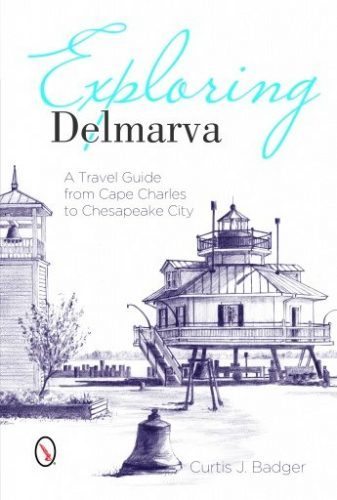Adventures Through Creeks and Meadows of the Mid-Atlantic Coast
By Luke Dowley
 Curtis J. Badger’s book Exploring Delmarva is a unique exploration guide, revealing many of the hidden gems to be found in DELaware, MARyland, and VirginiA.
Curtis J. Badger’s book Exploring Delmarva is a unique exploration guide, revealing many of the hidden gems to be found in DELaware, MARyland, and VirginiA.
Badger uses fifty short stories, each with the perfect level of concise intricacy, to paint a vivid road map of the area in all four seasons. His writing is beautifully light and easy to lose oneself in, making Delmarva a great Fall weekend read.
The adventures and experiences in Delmarva are told as Badger experienced them, ranging from long bike rides along the coast, to museum visits in tucked-away historic towns.
With each tale comes a detailed description of how exactly to experience the adventure yourself, the best way to travel there, and a myriad of options to customize the trip to fit your individual tastes. There is a trip for everyone to be found in Delmarva.
An Excerpt from Exploring Delmarva
Easton, Maryland is one of our family’s favorite places to visit, especially in the fall when the hardwoods show color, the geese are in the cornfields, and it’s time to break out the winter woolies.
Easton has a long tradition of waterfowl hunting, celebrated each November by the famous Wildfowl Festival, a carnival of wildlife art, antique decoys, duck-calling conventions, retriever demonstrations, and a myriad of other things having to do with the culture of the hunt.

Even if you’re not a hunter, the Easton area is a pleasant place to be, especially once you leave behind the traffic clutter of the U.S. Route 50 and take the back roads.
Easton is like many towns on Delmarva; you don’t see the best side when passing through on busy thoroughfares such as Route 50, Route 13, or Route 113. Hie thee to the back roads.
Easton, of course, has a lovely downtown, just a few blocks away from Route 50. There are restaurants, shops, galleries, and the stately Tidewater Inn, and if you visit during the Wildfowl Festival, the town is bustling with arts and crafts with an outdoor theme.
A 400-Acre Preserve
A few miles outside of town is another favorite place, Pickering Creek Audubon Center, a 400-acre preserve of farmland, forest, meadow, and tidal creeks. One of the initial pleasures of Pickering Creek is the simple matter of getting there.
Once you exit the Easton limits, the Talbot County is emphatically rural, with neat farms, woodlands, and an abundance of open space. Maryland has a wonderful system of secondary roads that make traveling on the back roads a pleasure.
The roadways are wide, well-maintained, and amazingly free of litter, exemplified by those leading to Pickering Creek.

Traveling west on Route 50, turn left at Airport Road in Easton and then immediately turn right onto Route 622 (Longwoods Road). Follow Route 622 to Sharp Road, turn left, and the center will be on your right. The Pickering Creek center is operated by the Chesapeake Audubon Society and includes Woodland, upland, and wetlands.
A Working Farm
It had long been a working farm, and though the property was donated to Audubon a number of years ago, 270 acres are still under production.
The farm, with a mile of shoreline on a tidal creek, was donated by Margaret Strahl and her brother, George Olds, in 1984. The family’s wish was that the property be accessible to all members of the community, and the center is open today, free of charge, from sunrise to sunset, 365 days a year.
While the fields at Pickering still produce crops, the mission today is environmental education. The center has become a leader in this regard, with 16,000 school children visiting each year to learn about the Chesapeake Bay watershed and how best to protect it.
Abundant Waterfowl to View
We go to Pickering Creek for the birding, which means abundant waterfowl in the fall and many colorful songbirds during the migration in the spring. There are open fields, meadows, hardwood swamps, shoreline, open water, freshwater ponds… just about any habitat you can think of, all of which means a great diversity of birds.
A hiking trail covers a wide variety of habitat and offers especially good birding in the spring and fall. The head of the trail is near the center office, which once was a songbird habitat. A variety of woodpeckers also live in the woods, as do barred and great-horned owls. Look for the rufous-sided towhees in the undergrowth.
The trail crosses several bogs and winds along the banks of the creek, where waterfowl and wading birds can be seen. It ends at the farm equipment sheds, where an organic demonstration garden is maintained.
Hawks Hunting
We usually walk back to the trailhead along the gravel road, where, often, there are hawks hunting over the cornfields and bluebirds along the field edges.
In the fall, great numbers of yellow-rumped warblers can be seen in this edge habitat where farm field, shrub, and forest meet.
One of the best birding spots is the bus parking lot, which is along the field edge just as the road enters the woods near the office building.
The sun is at your back during most daylight hours here, making it easier to see detail and color. There is a large walnut tree along the edge, along with numerous plants and shrubs in the fall.

Pickering Creek offers many programs for students and adults during the year. The center has more than 240 volunteers, who do everything from trail maintenance to leading field trips, so whether your interest is birds or botany, the center will likely have programs that will interest you.
Indeed, you may have a skill that the center could use and you might want to turn a visit into a volunteer opportunity. It has been known to happen.
Author Bio: Curtis J. Badger
Curtis J. Badger grew up in the Virginia portion of Delmarva, graduated from Salisbury University, and has written more than thirty books about the natural history and human history of the mid-Atlantic coast.
He is known for such works as Salt Tide, which was described by the Richmond Times-Dispatch as “a rare and glorious literary combination of natural history and memorable writing.” His most recent book, A Natural History of QuietWaters, is about the swamps and wetlands of the coast. Other books include The Wild Coast, Virginian’s Wild Side, Bellevue Farm, and Making Decoys the Century Old Way (with Grayson Chesser). He lives on Pungoteague Creek, not far from where he grew up.
Buy this book on Amazon Exploring Delmarva
- Saudi Arabia Might Be Your Next Getaway Spot - April 23, 2024
- Mongolia, the Land of Eternal Blue Sky - April 20, 2024
- These 9 U.S. National Parks Require Reservations in 2024 - April 17, 2024






Good stuff. I appreciate your local knowledge of wildlife and want to visit the Pickering Creek Audubon Center after reading this.